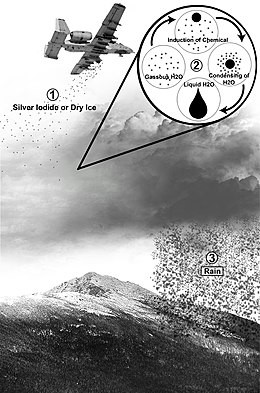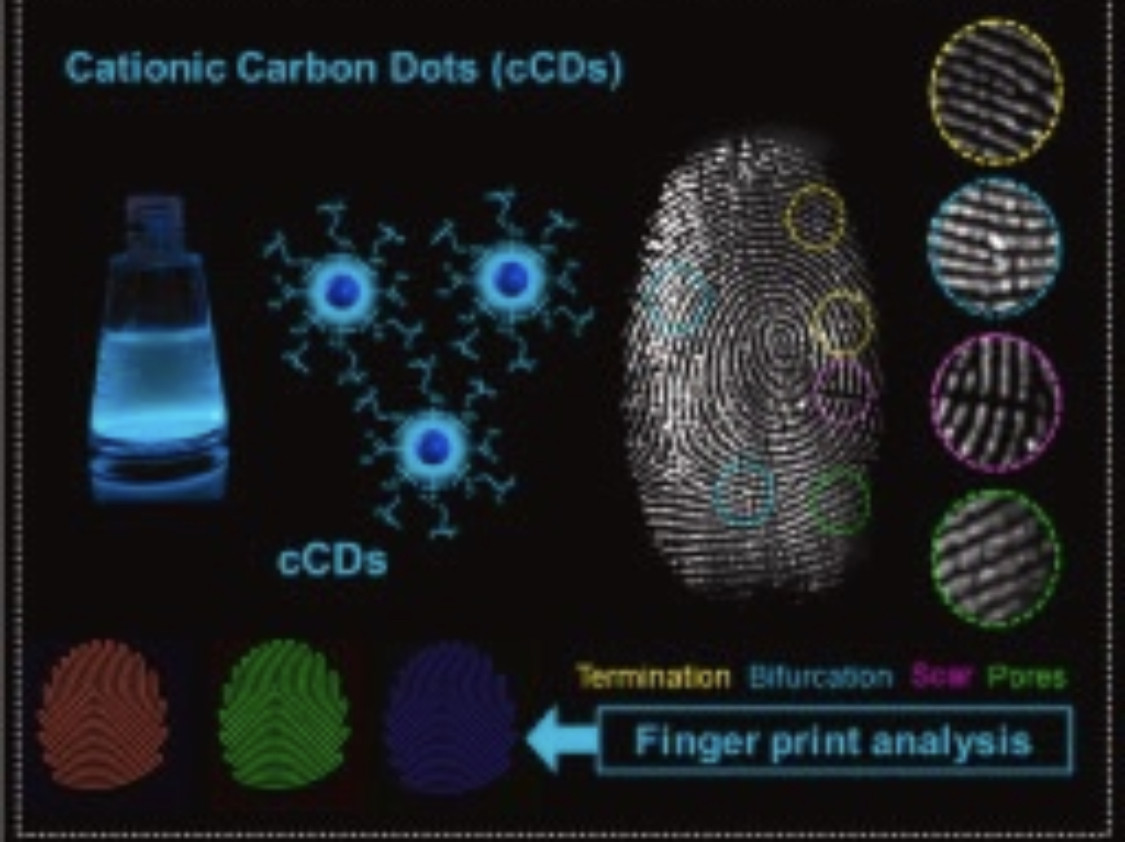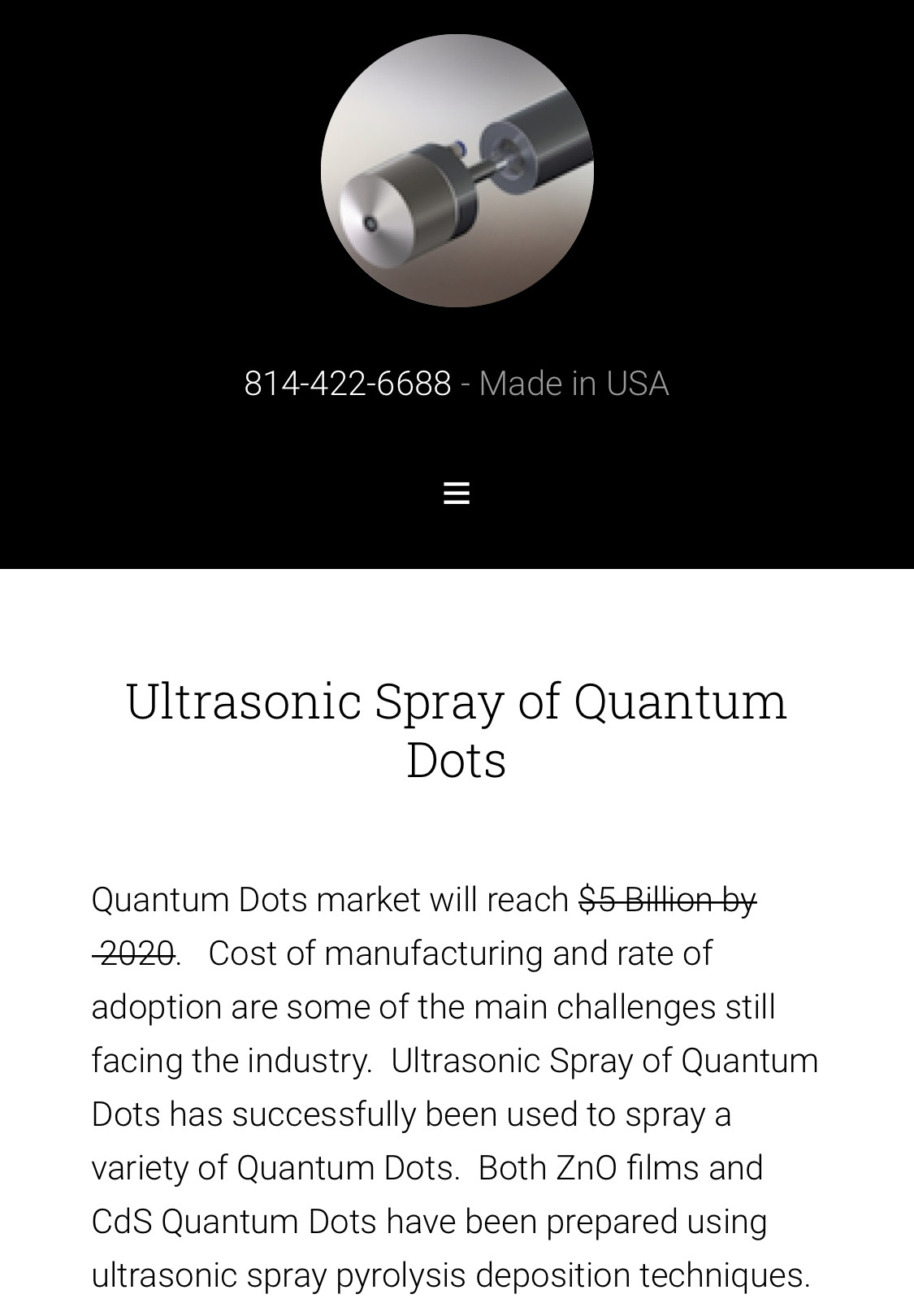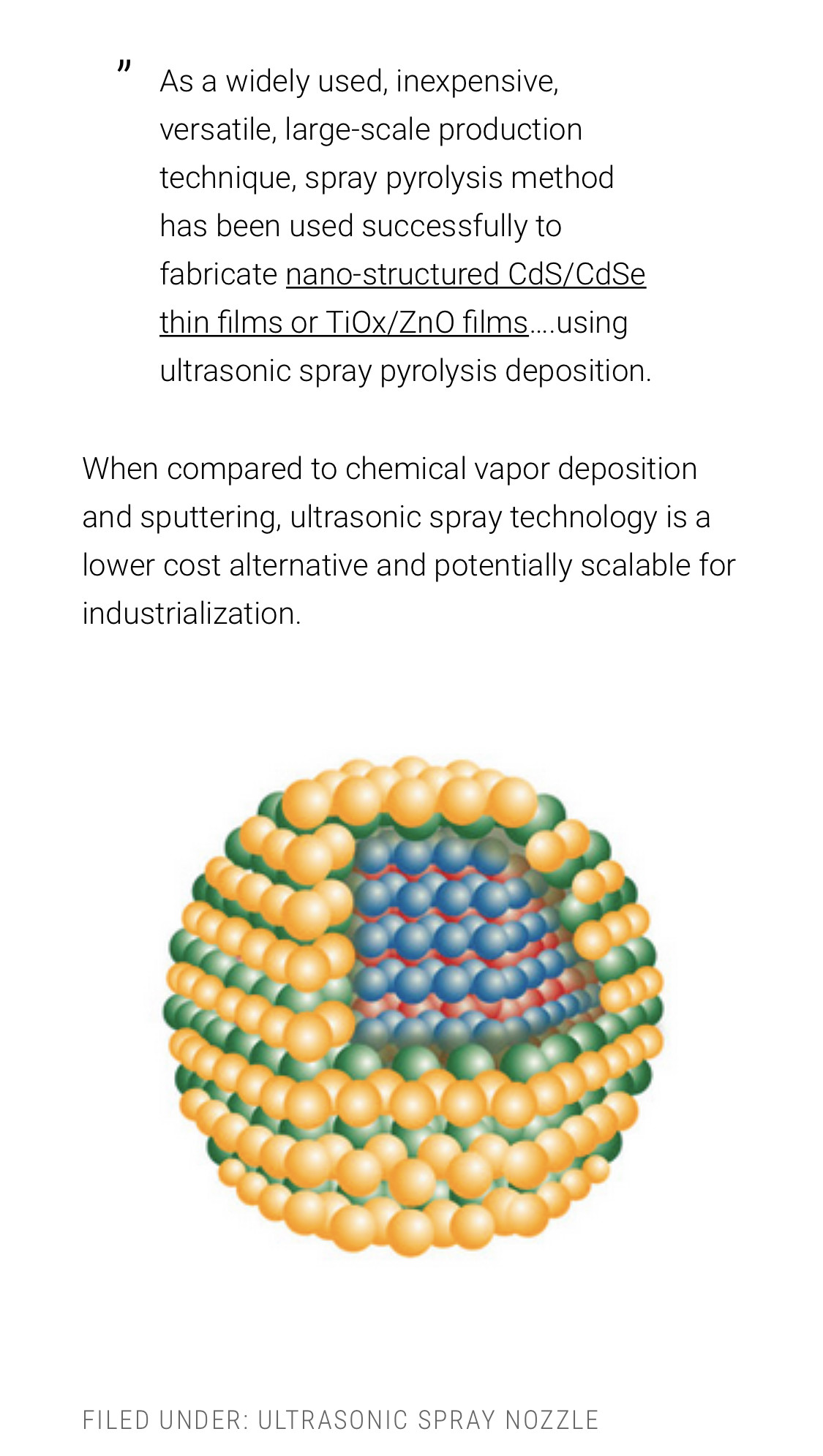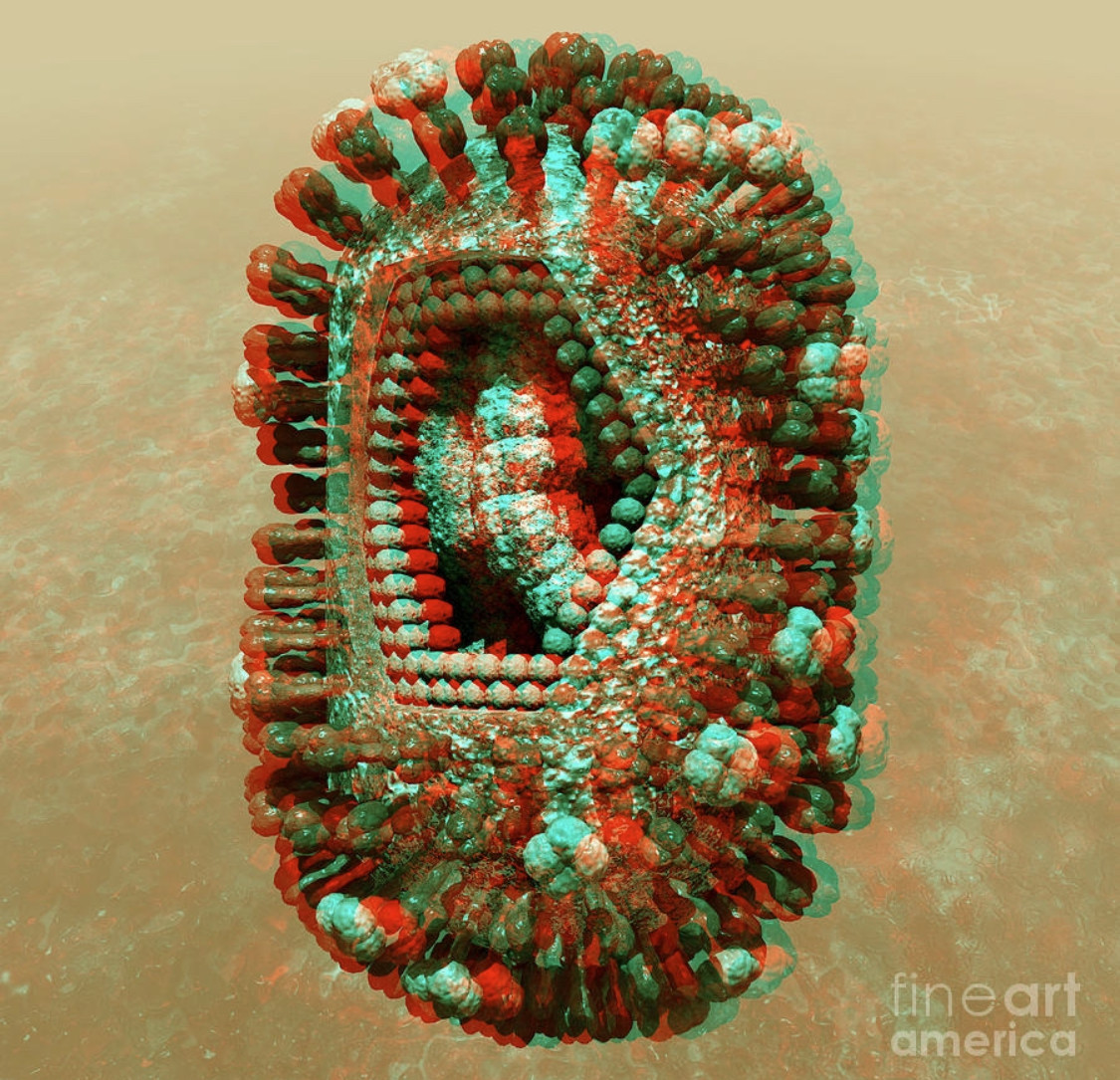The Mac
@TheMac
06 August, 08:03
Notice: Undefined index: tg1tga_access in /home/admin/www/anonup.com/themes/default/apps/timeline/post.phtml on line 396
Mr. Boxoffrogs
@boxoffrogs
06 August, 08:45
In response The Mac to his Publication
Except it's not silver iodine... it's aluminum, strontium, and beryllium... all much cheaper and much more toxic.
Notice: Undefined index: tg1tga_access in /home/admin/www/anonup.com/themes/default/apps/timeline/post.phtml on line 396
Mr. Boxoffrogs
@boxoffrogs
06 August, 08:46
In response Mr. Boxoffrogs to his Publication
Notice: Undefined index: tg1tga_access in /home/admin/www/anonup.com/themes/default/apps/timeline/post.phtml on line 396
The Mac
@TheMac
06 August, 09:46
In response Mr. Boxoffrogs to his Publication
Silver nanoparticles produce a stronger plasmon resonance than gold nanoparticles it can be due to the large reflectivity from the metal surface. TEM images indicate that change in the size of nanoparticles with increasing the laser fluence is in good agreement with the Mie theory.
Notice: Undefined index: tg1tga_access in /home/admin/www/anonup.com/themes/default/apps/timeline/post.phtml on line 396
Mr. Boxoffrogs
@boxoffrogs
06 August, 10:13
In response The Mac to his Publication
The list of common ferrous metal properties include: Durable Good tensile strength Good electrical conductivity Low corrosion resistance Silver in colour Recyclable Usually magnetic Ferrous metals can include a wide range of different alloying elements, including chromium, nickel, manganese, molybdenum, and vanadium, manganese. Are we going down a climate change rabbit hole here? Silver is too expensive. They are using exactly the metals found in the rainwater samples, appearing as Aluminum, Beryllium and Strontium. It has killed several species of plants in my yard both here and in Maryland where I lived when this program began. https://youtu.be/Zbkwjno7T...
Notice: Undefined index: tg1tga_access in /home/admin/www/anonup.com/themes/default/apps/timeline/post.phtml on line 396
The Mac
@TheMac
06 August, 11:32
In response Mr. Boxoffrogs to his Publication
hold on..
Notice: Undefined index: tg1tga_access in /home/admin/www/anonup.com/themes/default/apps/timeline/post.phtml on line 396
The Mac
@TheMac
06 August, 11:47
In response The Mac to his Publication
Notice: Undefined index: tg1tga_access in /home/admin/www/anonup.com/themes/default/apps/timeline/post.phtml on line 396
The Mac
@TheMac
06 August, 11:48
In response The Mac to his Publication
Notice: Undefined index: tg1tga_access in /home/admin/www/anonup.com/themes/default/apps/timeline/post.phtml on line 396
The Mac
@TheMac
06 August, 11:50
In response The Mac to his Publication
Notice: Undefined index: tg1tga_access in /home/admin/www/anonup.com/themes/default/apps/timeline/post.phtml on line 396
The Mac
@TheMac
06 August, 11:50
In response The Mac to his Publication
Coal is the most abundant and readily combustible energy resource being used worldwide. However, its structural characteristic creates a perception that coal is only useful for producing energy via burning. Here we report a facile approach to synthesize tunable graphene quantum dots from various types of coal, and establish that the unique coal structure has an advantage over pure sp2-carbon allotropes for producing quantum dots.
Notice: Undefined index: tg1tga_access in /home/admin/www/anonup.com/themes/default/apps/timeline/post.phtml on line 396
The Mac
@TheMac
06 August, 11:51
In response The Mac to his Publication
The crystalline carbon within the coal structure is easier to oxidatively displace than when pure sp2-carbon structures are used, resulting in nanometre-sized graphene quantum dots with amorphous carbon addends on the edges. The synthesized graphene quantum dots, produced in up to 20% isolated yield from coal, are soluble and fluorescent in aqueous solution, providing promise for applications in areas such as bioimaging, biomedicine, photovoltaics and optoelectronics, in addition to being inexpensive additives for structural composites.
Notice: Undefined index: tg1tga_access in /home/admin/www/anonup.com/themes/default/apps/timeline/post.phtml on line 396
The Mac
@TheMac
06 August, 11:53
In response The Mac to his Publication
Notice: Undefined index: tg1tga_access in /home/admin/www/anonup.com/themes/default/apps/timeline/post.phtml on line 396
The Mac
@TheMac
06 August, 11:53
In response The Mac to his Publication
Notice: Undefined index: tg1tga_access in /home/admin/www/anonup.com/themes/default/apps/timeline/post.phtml on line 396
The Mac
@TheMac
06 August, 11:53
In response The Mac to his Publication
Notice: Undefined index: tg1tga_access in /home/admin/www/anonup.com/themes/default/apps/timeline/post.phtml on line 396
The Mac
@TheMac
06 August, 11:54
In response The Mac to his Publication
Notice: Undefined index: tg1tga_access in /home/admin/www/anonup.com/themes/default/apps/timeline/post.phtml on line 396
The Mac
@TheMac
06 August, 11:55
In response The Mac to his Publication
Notice: Undefined index: tg1tga_access in /home/admin/www/anonup.com/themes/default/apps/timeline/post.phtml on line 396
06 August, 12:35
In response The Mac to his Publication
They dont crash like that, they disappear into ground holes. 😁
Notice: Undefined index: tg1tga_access in /home/admin/www/anonup.com/themes/default/apps/timeline/post.phtml on line 396
The Mac
@TheMac
06 August, 10:34
In response Jason VanDerpoel to his Publication
Think fuel?
Notice: Undefined index: tg1tga_access in /home/admin/www/anonup.com/themes/default/apps/timeline/post.phtml on line 396
The Mac
@TheMac
06 August, 10:36
In response The Mac to his Publication
Notice: Undefined index: tg1tga_access in /home/admin/www/anonup.com/themes/default/apps/timeline/post.phtml on line 396
06 August, 10:37
In response The Mac to his Publication
I understand brother.
Notice: Undefined index: tg1tga_access in /home/admin/www/anonup.com/themes/default/apps/timeline/post.phtml on line 396
The Mac
@TheMac
06 August, 10:38
In response Jason VanDerpoel to his Publication
Mechanical sound wave which has periodic vibrations and frequencies of more than 20 KHz, which in turn is more than upper human audible range frequency, is known as ultrasound (US) wave (Abu Zidan et al. 2011). It is produced through a transducer that utilizes piezoelectric component or an electromagnetic inductor which has the capability of converting electrical signal into mechanical vibrations and vice versa (Hangiandreou 2003).
Notice: Undefined index: tg1tga_access in /home/admin/www/anonup.com/themes/default/apps/timeline/post.phtml on line 396
The Mac
@TheMac
06 August, 10:40
In response The Mac to his Publication
The vibration of Fe3O4 nanoparticles in response to an alternating magnetic field can be sensitively detected using contact mode atomic force microscopy (AFM) combined with selective modulation of magnetic domains. While imaging patterned samples of magnetic nanoparticles with contact mode AFM, a magnetic field was applied to drive sample vibration. The field altered in polarity and strength according to parameters of an AC current applied to a solenoid located under the sample. The vibration of Fe3O4 nanoparticles was detected by a nonmagnetic AFM tip to map the changes in frequency and amplitude of the vibrating sample at the level of individual Fe3O4 nanoparticles and clusters.
Notice: Undefined index: tg1tga_access in /home/admin/www/anonup.com/themes/default/apps/timeline/post.phtml on line 396
The Mac
@TheMac
06 August, 10:40
In response The Mac to his Publication
Colloidal lithography was used to prepare patterns of Fe3O4 nanoparticles on a glass surface using basic steps of mixing, drying and removing the surface template of latex spheres. Monodisperse latex were used to guide the deposition of magnetic nanoparticles to collect in the spaces in between the close-packed spheres of the latex film. With a mixture approach of “two-particle” lithography, 2D arrays of patterned aggregates of metal nanoparticles were generated which formed a periodic, well-defined arrangement that was suitable for subsequent characterizations with magnetic sample modulation (MSM).
Notice: Undefined index: tg1tga_access in /home/admin/www/anonup.com/themes/default/apps/timeline/post.phtml on line 396
The Mac
@TheMac
06 August, 10:42
In response The Mac to his Publication
To perform a study, the person is positioned within an MRI scanner that forms a strong magnetic field around the area to be imaged. First, energy from an oscillating magnetic field is temporarily applied to the patient at the appropriate resonance frequency. Scanning with X and Y gradient coils causes a selected region of the patient to experience the exact magnetic field required for the energy to be absorbed. The atoms are excited by a radio frequency (RF) pulse and the resultant signal is measured by a receiving coil. The RF signal may be processed to deduce position information by looking at the changes in RF level and phase caused by varying the local magnetic field using gradient coils.
Notice: Undefined index: tg1tga_access in /home/admin/www/anonup.com/themes/default/apps/timeline/post.phtml on line 396
The Mac
@TheMac
06 August, 10:43
In response The Mac to his Publication
As these coils are rapidly switched during the excitation and response to perform a moving line scan, they create the characteristic repetitive noise of an MRI scan as the windings move slightly due to magnetostriction. The contrast between different tissues is determined by the rate at which excited atoms return to the equilibrium state. Exogenous contrast agents may be given to the person to make the image clearer.
Notice: Undefined index: tg1tga_access in /home/admin/www/anonup.com/themes/default/apps/timeline/post.phtml on line 396
06 August, 10:44
In response The Mac to his Publication
Why do I always feel like your the guy trying to wake me up from a coma, and when I come to, you like, "dude I couldnt have said it any simpler". Love You Man. 🙏❤️
Notice: Undefined index: tg1tga_access in /home/admin/www/anonup.com/themes/default/apps/timeline/post.phtml on line 396
The Mac
@TheMac
06 August, 10:51
In response Jason VanDerpoel to his Publication
The major structural material employed in the towers was A36 structural steel, although higher strength steel was used in the lower elevations of the structure. Except for some selected floors, for which normal strength concrete was employed, the
composite
slabs were made of a 21MPa (3ksi) lightweight concrete
composite
slabs were made of a 21MPa (3ksi) lightweight concrete
Notice: Undefined index: tg1tga_access in /home/admin/www/anonup.com/themes/default/apps/timeline/post.phtml on line 396
06 August, 10:53
In response The Mac to his Publication
👀
Notice: Undefined index: tg1tga_access in /home/admin/www/anonup.com/themes/default/apps/timeline/post.phtml on line 396
The Mac
@TheMac
06 August, 10:57
In response Jason VanDerpoel to his Publication
The cement-based materials can be mixed with nanomaterials such as nano-silica (nano-SiO2), nano-alumina (nano-Al2O3), nano-ferric oxide (nano-Fe2O3), nano-titanium oxide (nano-TiO2), carbon nanotubes (CNTs), graphene and graphene oxide.
Notice: Undefined index: tg1tga_access in /home/admin/www/anonup.com/themes/default/apps/timeline/post.phtml on line 396
The Mac
@TheMac
06 August, 10:58
In response The Mac to his Publication
Nanotechnology improves the bulk property of concrete, helps to obtain thinner final products, faster setting time and lowered levels of environmental attack. Some of the novel advancement on nanotechnology is its ability to use marginal and recycled materials.
Notice: Undefined index: tg1tga_access in /home/admin/www/anonup.com/themes/default/apps/timeline/post.phtml on line 396
The Mac
@TheMac
06 August, 10:59
In response The Mac to his Publication
Nanoconcrete (also spelled nano concrete or nano-concrete) is a form of concrete that contains Portland cement particles that are no greater than 100 μm[1] and particles of silica no greater than 500 μm, which fill voids that would otherwise occur in normal concrete, thereby substantially increasing the material's strength.[2] It is also a product of high-energy mixing (HEM) of conventional cement, sand and water which is a bottom-up approach of nano technology.
Notice: Undefined index: tg1tga_access in /home/admin/www/anonup.com/themes/default/apps/timeline/post.phtml on line 396
The Mac
@TheMac
06 August, 11:00
In response The Mac to his Publication
The incorporation of ultra-fine particles into a Portland-cement paste within a concrete mixture in accordance with top-down approach of nano technology alters the concrete's material properties and performance by reducing the void space between the cement and aggregate in the cured concrete. This improves strength, durability, shrinkage and bonding to steel reinforcing bars.
Notice: Undefined index: tg1tga_access in /home/admin/www/anonup.com/themes/default/apps/timeline/post.phtml on line 396
The Mac
@TheMac
06 August, 11:04
In response The Mac to his Publication
It is now well-understood that incorporation of nanoparticles can enhance the physico-mechanical properties of cement mortar composites. However, there is still little information on the influence of the dosage and chemistry of nanoparticles on the physico-chemical properties of the composites. In this paper, nano-modified cement mortar composites containing 0.0, 2.0, 2.5 and 3.0 wt% of iron oxide (IO) nanoparticles were prepared and their mechanical properties including compressive and flexural strengths were investigated. The results show that the influence of nanoparticle addition is mainly on the growth and change of the calcium silicate hydrate (C–S–H) crystals, which ultimately has an impact on the mechanical properties of the composite.
Notice: Undefined index: tg1tga_access in /home/admin/www/anonup.com/themes/default/apps/timeline/post.phtml on line 396
The Mac
@TheMac
06 August, 11:06
In response The Mac to his Publication
Because the unpaired electrons make a material magnetic, iron oxide is less magnetic than iron. Iron oxide is therefore called a paramagnetic material.
Notice: Undefined index: tg1tga_access in /home/admin/www/anonup.com/themes/default/apps/timeline/post.phtml on line 396
The Mac
@TheMac
06 August, 11:06
In response The Mac to his Publication
Electron paramagnetic resonance or electron spin resonance spectroscopy is a method for studying materials that have unpaired electrons. The basic concepts of EPR are analogous to those of nuclear magnetic resonance, but the spins excited are those of the electrons instead of the atomic nuclei.
Notice: Undefined index: tg1tga_access in /home/admin/www/anonup.com/themes/default/apps/timeline/post.phtml on line 396
The Mac
@TheMac
06 August, 11:09
In response The Mac to his Publication
Here we report the direct visualization of biomimetic
iron oxide nanoparticle nucleation
mediated by an acidic bacterial recombinant protein, Mms6, during an in situ reaction induced by the controlled addition of sodium hydroxide to solution-phase Mms6 protein micelles incubated with ferric chloride. Using in situ liquid cell scanning transmission electron microscopy we observe the liquid iron prenucleation phase and nascent amorphous nanoparticles forming preferentially on the surface of protein micelles. Our results provide insight into the early steps of protein-mediated biomimetic nucleation of iron oxide and point to the importance of an extended protein surface during nanoparticle formation.
iron oxide nanoparticle nucleation
mediated by an acidic bacterial recombinant protein, Mms6, during an in situ reaction induced by the controlled addition of sodium hydroxide to solution-phase Mms6 protein micelles incubated with ferric chloride. Using in situ liquid cell scanning transmission electron microscopy we observe the liquid iron prenucleation phase and nascent amorphous nanoparticles forming preferentially on the surface of protein micelles. Our results provide insight into the early steps of protein-mediated biomimetic nucleation of iron oxide and point to the importance of an extended protein surface during nanoparticle formation.
Notice: Undefined index: tg1tga_access in /home/admin/www/anonup.com/themes/default/apps/timeline/post.phtml on line 396
The Mac
@TheMac
06 August, 11:10
In response The Mac to his Publication
Introduction. Iron oxide minerals are ubiquitous in natural environments (Straub et al., 2001; Kappler and Straub, 2005; Braunschweig et al., 2013) and exist chemically as amorphous, poorly crystalline or crystalline phases (Cornell and Schwertmann, 2003).9 Oct 2018
Notice: Undefined index: tg1tga_access in /home/admin/www/anonup.com/themes/default/apps/timeline/post.phtml on line 396
The Mac
@TheMac
06 August, 11:11
In response The Mac to his Publication
Sonocrystallization involves the application of ultrasound energy to control the nucleation and crystal growth of a crystallization process.
Notice: Undefined index: tg1tga_access in /home/admin/www/anonup.com/themes/default/apps/timeline/post.phtml on line 396
The Mac
@TheMac
06 August, 11:12
In response The Mac to his Publication
The positive influence of ultrasound (US) on crystallization processes is shown by the dramatic reduction of the induction period, supersaturation conditions and metastable zone width. Manipulation of this influence can be achieved by changing US-related variables such as frequency, intensity, power and even geometrical characteristics of the ultrasonic device (e.g. horn type size). The volume of the sonicated solution and irradiation time are also variables to be optimized in a case-by-case basis as the mechanisms of US action on crystallization remain to be established. Nevertheless, the results obtained so far make foreseeable that crystal size distribution, and even crystal shape, can be ‘tailored’ by appropriate selection of the sonication conditions.
Notice: Undefined index: tg1tga_access in /home/admin/www/anonup.com/themes/default/apps/timeline/post.phtml on line 396
The Mac
@TheMac
06 August, 11:13
In response The Mac to his Publication
A horn antenna or microwave horn is an antenna that consists of a flaring metal waveguide shaped like a horn to direct radio waves in a beam.
Notice: Undefined index: tg1tga_access in /home/admin/www/anonup.com/themes/default/apps/timeline/post.phtml on line 396
The Mac
@TheMac
06 August, 11:14
In response The Mac to his Publication
A directed-energy weapon (DEW) is a ranged weapon that damages its target with highly focused energy without a solid projectile, including lasers, microwaves, particle beams, and sound beams.
Notice: Undefined index: tg1tga_access in /home/admin/www/anonup.com/themes/default/apps/timeline/post.phtml on line 396
The Mac
@TheMac
06 August, 11:17
In response The Mac to his Publication
As was mentioned in Lesson 4, musical instruments are set into vibrational motion at their natural frequency when a person hits, strikes, strums, plucks or somehow disturbs the object. Each natural frequency of the object is associated with one of the many standing wave patterns by which that object could vibrate. The natural frequencies of a musical instrument are sometimes referred to as the harmonics of the instrument. An instrument can be forced into vibrating at one of its harmonics (with one of its standing wave patterns) if another interconnected object pushes it with one of those frequencies. This is known as resonance - when one object vibrating at the same natural frequency of a second object forces that second object into vibrational motion
Notice: Undefined index: tg1tga_access in /home/admin/www/anonup.com/themes/default/apps/timeline/post.phtml on line 396
The Mac
@TheMac
06 August, 11:21
In response The Mac to his Publication
The ground also has a specific resonant frequency. Hard bedrock has higher frequencies softer sediments. If the period of ground motion matches the natural resonance of a building, it will undergo the largest oscillations possible and suffer the greatest damage.
Notice: Undefined index: tg1tga_access in /home/admin/www/anonup.com/themes/default/apps/timeline/post.phtml on line 396
The Mac
@TheMac
06 August, 11:23
In response The Mac to his Publication
Magnetic iron oxide nanoparticles (MIONs) have attracted enormous attention due to their wide applications, including for magnetic separation, for magnetic hyperthermia, and as contrast agents for magnetic resonance imaging (MRI).
Notice: Undefined index: tg1tga_access in /home/admin/www/anonup.com/themes/default/apps/timeline/post.phtml on line 396
Magnetic separation is the process of separating components of mixtures by using a magnet to attract magnetic substances.[1] The process that is used for magnetic separation separates non-magnetic substances from those which are magnetic. This technique is useful for the select few minerals which are ferromagnetic (iron-, nickel-, and cobalt-containing minerals) and paramagnetic.
11:24 PM - Aug 06, 2022
In response The Mac to his Publication
Only people mentioned by TheMac in this post can reply
The Mac
@TheMac
06 August, 11:29
In response The Mac to his Publication
Generally, electrostatic charges are used to attract or repel differently charged material.[1] When electrostatic separation uses the force of attraction to sort particles, conducting particles stick to an oppositely charged object, such as a metal drum, thereby separating them from the particle mixture. When this type of beneficiation uses repelling force, it is normally employed to change the trajectory of falling objects to sort them into different places. This way, when a mixture of particles falls past a repelling object, the particles with the correct charge fall away from the other particles when they are repelled by the similarly charged object.
An electric charge can be positive or negative — objects with a positive charge repel other positively charged objects, thereby causing them to push away from each other, while a positively charged object would attract to a negatively charged object, thereby causing the two to draw together.
An electric charge can be positive or negative — objects with a positive charge repel other positively charged objects, thereby causing them to push away from each other, while a positively charged object would attract to a negatively charged object, thereby causing the two to draw together.
Notice: Undefined index: tg1tga_access in /home/admin/www/anonup.com/themes/default/apps/timeline/post.phtml on line 396
The Mac
@TheMac
06 August, 11:40
In response The Mac to his Publication
🙏🏻
Notice: Undefined index: tg1tga_access in /home/admin/www/anonup.com/themes/default/apps/timeline/post.phtml on line 396

